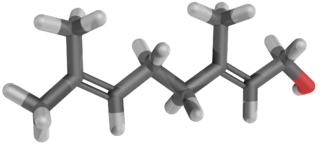Team:AUC Turkey/Project/Geraniol
From 2012hs.igem.org
| Sponsors | ||
|---|---|---|

|

|

|
Geraniol
Geraniol is a monoterpenoid and an alcohol. It’s molecular formula is C10H18O . It is the primary part of rose oil, palmarosa oil, and citronella oil (Java type). It also occurs in small quantities in geranium, lemon, and many other essential oils. It appears as a clear to pale-yellow oil that is insoluble in water, but soluble in most common organic solvents. It has a rose-like odor and is commonly used in perfumes. It is used in flavors such as peach, raspberry, grapefruit, red apple, plum, lime, orange, lemon, watermelon, pineapple, and blueberry. Geraniol found in Geranium and Pelargonium.Geranium is found throughout the temperate regions of the world and the mountains of the tropics, but mostly in the eastern part of the Mediterranean .Pelargonium is a genus of flowering plants which includes about 200 species of perennials, succulents, and shrubs, commonly known as scented geraniums or storksbills. It is found in South Africa
Health Benefits of Geraniol
Geraniol is a natural antioxidant. Geraniol has been suggested to help prevent cancer. Carnesecchi S. et al demonstrated in his study "Geraniol, a component of Plant Essential Oils, Inhibits Grwoth and Polyamine Biosyntehsis in Human Colon Cancer Cells", (Pharmacology, July 2001) that geraniol caused a 50% increase of ornithine decarboxylase activity, which is enhances during cancer growth. Geraniol inhibits DNA synthesis.
Burk YD concluded in his study "Inhibition of Pancreatic Cancer Growth by the dietary isoprenoids farnesol and geraniol" (Lipids, February 1997) that geraniol, farnesol and perilll alcohol suppress pancreatic tumor growth.
Other animal studies have also demonstrated the anticancer effects of geraniol.
Facts about Geraniol
Geraniol is mainly used in perfumery and flavouring.
Synonyms
Lemonol, beta-Geraniol, trans-3,7-Dimethyl-2,6-octadien-1-ol

<forum_subtle/>
 "
"
